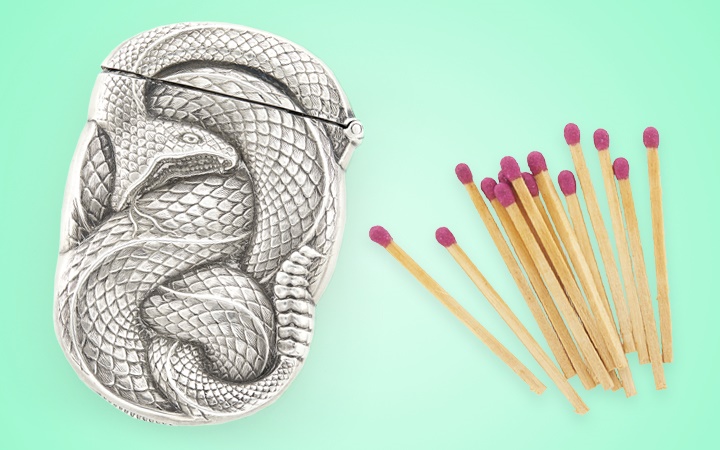Matchsafes & Vesta from the Joseph & Miriam Poser Collection
02/15/2021 Furniture & Decorative Arts

NEW YORK, NY -- Rapid developments in technology have for many centuries been at the forefront of human development. Though these leaps forward look very different now, even in the 19th century there were innovations that rapidly changed the lives of many. One such development was the invention of the friction match. Like the Internet in the late 20th century, the ability to master fire and light fundamentally changed the world.
Until the 1830s, if one needed fire to see or stay warm the best bet was the flint and steel method, which by no means assured success. When the friction match appeared, darkness and cold were banished with a single strike. At the dawn of this new era, the chemical makeup of the matches remained unstable enough that any aggressive friction might cause the matches to ignite in your pocket. Understanding that this was not ideal, people soon came up with a creative solution. Very quickly, little boxes were used to carry around matches – these were known in America as matchsafes and in Britain as vesta cases (matches were called vestas) after the Roman goddess of the hearth and fire – trust it to the Brits to be so romantic!
So appeared matchsafes in materials such as tin, brass and copper for the working man. More elevated social classes used silver and silver plate, while the very wealthy had luxurious examples in gold, set with precious gemstones. The majority of matchsafes were small rectangular boxes measuring a few inches long, often with a ring to attach to a watch chain or chatelaine.
American silversmiths jumped on the matchsafe craze from the very beginning. There was a huge audience for matchsafes, because almost everyone carried matches; men for work and smoking and women for tending the home hearth and kitchen fires, and lighting lamps. By the early 1900s America was producing and using over 1 billion matches every day, so the appetite for matchsafes reached extraordinary heights. In 1902, American silversmith Unger Bros. advertised 300 different styles of matchsafes in their catalogue. Matchsafes were an ideal way to hook new clients by selling them an affordable piece of silver that served as a reminder of the other goods the merchant could offer.
Makers soon transformed matchsafes into every form imaginable. From 1860 to 1930 over 1,200 patents were taken out in the USA alone for matchsafes, and it is thought there could be as many as 10,000 variations made worldwide! These objects were a reflection of a person’s personal taste and also an outward sign of their wealth and social standing. They were also very much of their time, so styles and forms shifted over the 70 years they were popular. In an 1893 advertisement, American silversmith William B. Kerr debuted a silver matchsafe collection featuring the great masterpieces of the popular contemporary French painter William Adolphe Bouguereau, examples of which are included in the Joseph & Miriam Poser Collection. Other examples took the form of novelties; cigars, playing cards, wine bottles, popular figures (both real and drawn from literature), fish and sea life, dragons and snakes.
Among matchsafe collectors, there are many genres to consider -- you can buy only matchsafes that promote period advertising, sports, or nature. The Joseph & Miriam Poser Collection includes a variety of examples to meet every taste. A popular matchsafe from the advertising section is for “The Home Insurance Company of New York,” with their logo to one side and a scene of firefighters to the reverse -- a fitting subject for a matchsafe, as well as a great promotional tool for a company ready to insure homes against any mishaps a match might cause. Sporting examples include all the pastimes of the late 19th and early 20th century: golf, tennis, polo and hunting. Novelty matchsafes would have been prized possessions to share a laugh with friends and remain charming examples of the period.
The heyday of matchsafes was 1890 to 1910, from the time cigarette smoking took off across Europe and America to when friction matches were replaced by paper matchbooks and gas pocket lighters. Interestingly, matchbooks took on the mantel of advertising on their covers in a far greater way than matchsafes ever could and have become collectible in their own way. The latest case in the collection is by famed English jewelers Mappin & Webb and dates to 1922, by which time it would have been a relic of another age – exactly what collectors look for today!
The Joseph & Miriam Poser Collection of Silver Card Cases, Vesta & Matchsafes
Timed Auction Closes Thursday, February 25, 2021 Beginning at 10am
Exhibition Sat, Feb 20 - Mon, Feb 22, Noon - 5pm